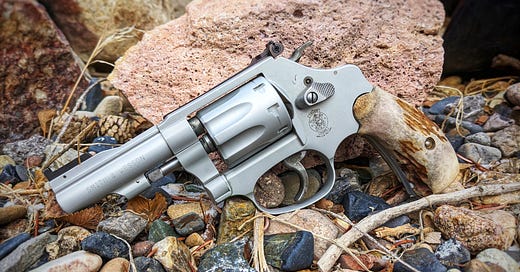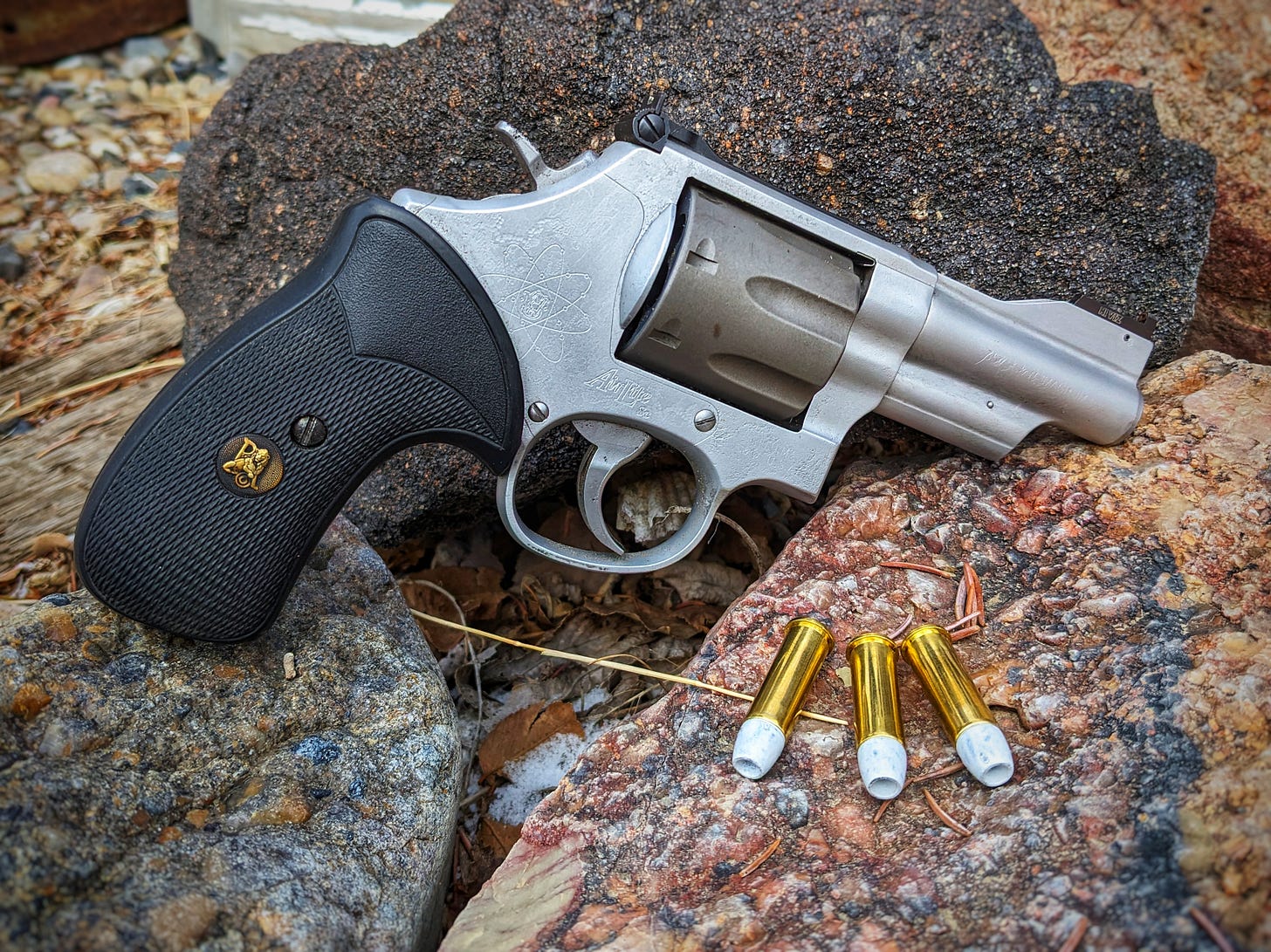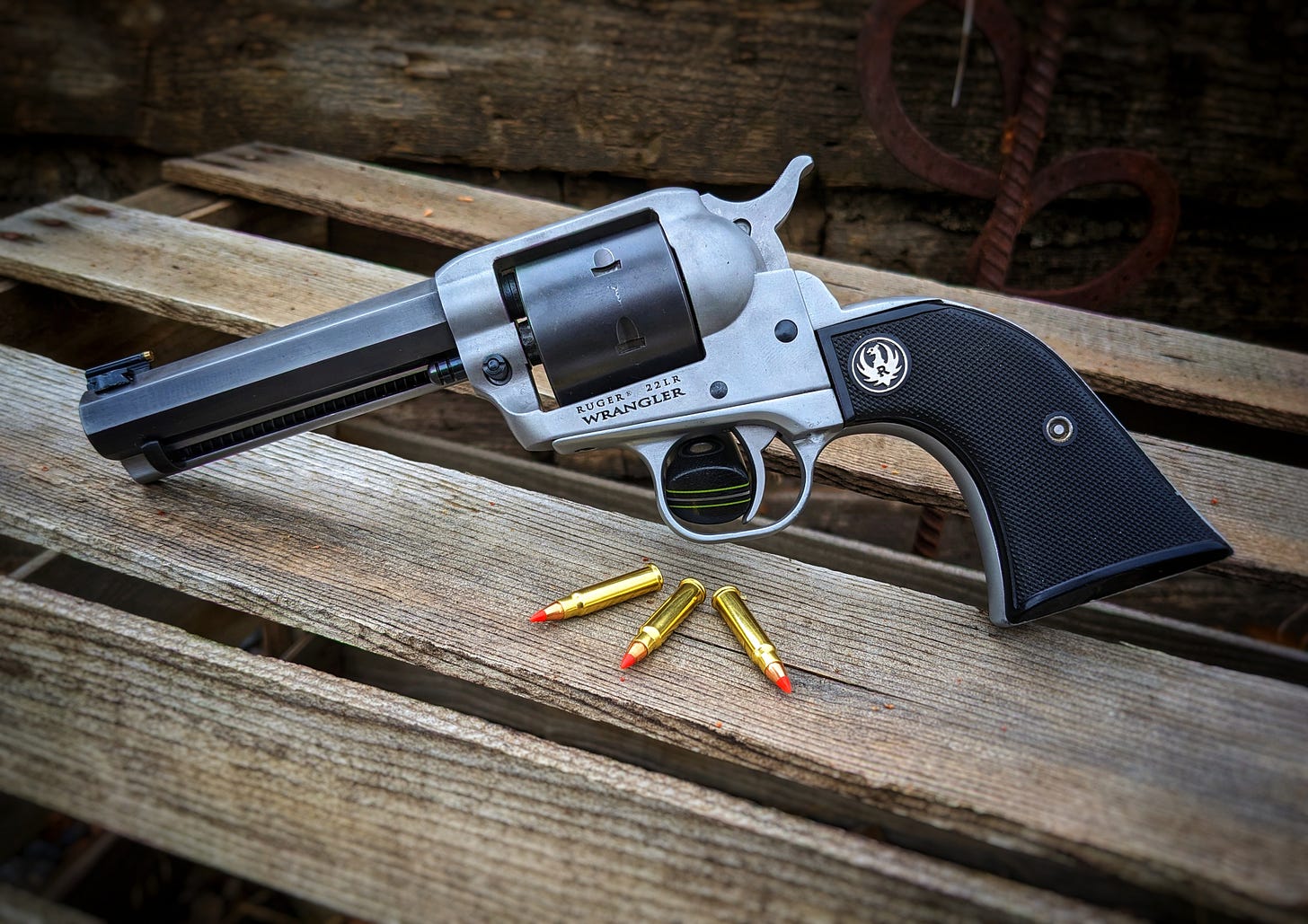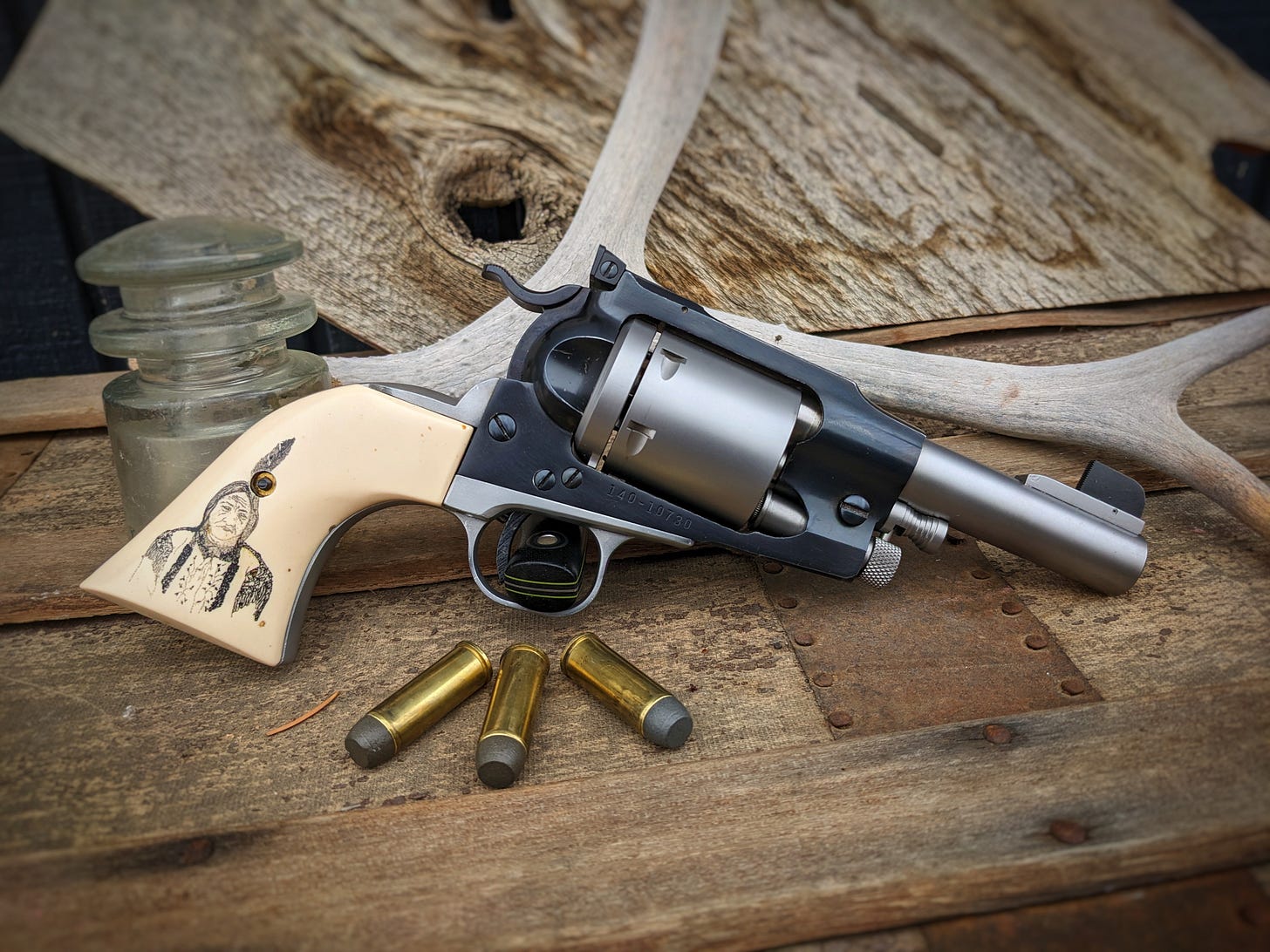Everyone should have a trail gun. What's a trail gun, you say? Well, that was easy to define right up until I started writing an article on trail guns. At first, I thought I would be writing a nice short article on light packing revolvers, but the more I thought about it, the term “trail gun” really can’t be applied to just revolvers or even handguns, for that matter. Don’t worry, I will include revolvers. I write about what I like, but I will also include some guns that may surprise you.
What’s a trail gun?
Initially, I thought a trail gun was a light handgun suitable for carrying on a long walk. That hasn’t changed, but as I sat down to write this, I realized that a trail gun is a light firearm, but more importantly, a useful do-it-all gun tailored to the environment in which it’s being carried. Is there really an ultimate trail gun? No, because there is no ultimate trail. My quiet walk in the woods has a much different look than a person in Alaska or Florida, and the trail guns for each of those people would need to be quite different. I have spent a lot of time wandering around northern Nevada and have yet to run into a grizzly, or a croc, for that matter. So, how do I begin to define a single firearm that an outdoorsman might ask to kill a rogue moose or dispatch a cottontail for supper? I’m not sure if I can. I’m unsure if "trail gun" is specific enough of a title to boil it down to one gun or even a single category of firearms. So, let's talk about what a trail gun needs to be.
Reliable: Functionality is foremost. A trail gun needs to be ready to go at a moment's notice and be able to perform.
Handy: I was tempted to write lightweight here, but when comparing apples to oranges, it doesn't apply. A rifle will never be as light as a handgun, but it does need to be a pleasure to carry, regardless of design.
Capable: Your trail gun needs to be able to perform the day's tasks. If that means it needs to protect you from wolves or dispatch a tree squirrel, then so be it. In this case, the trail dictates what we will look to carry.
Nostalgia: This one may not make everyone's list, but it makes mine. There are plenty of practical and capable guns out there. For me, if I'm going to take a gun for a walk, then it needs to be more than just a weapon. It needs to speak to me, and when I shoot, I need to feel joy as well as recoil.
The guns
Let’s begin with my favorite, all-time, hands-down trail gun. It has gone by many model designations before, but Smith & Wesson has always carried a “kit gun” in their line. The original kit gun is a handy little revolver you could throw in your tackle box or the glove box of your truck. It was a gun you could keep in your kit, just so you always had one. Mine is the most recent iteration of the kit gun, the model 317. The 317 is an all-aluminum revolver in the J frame size. It has a three-inch barrel and adjustable sights, backed up by an eight-shot .22 LR cylinder. I have made a few changes to my gun. I replaced the three-finger rubber grips with ones I made myself from mule deer antler. I also changed the sights.
Smith used a V-notch rear sight and a fiber optic bead on the front of this revolver. Why is beyond me; in my mind, that is a combat sight and not meant for the precision, take-the-head-off-a-rattler work that a trail gun needs to accomplish. I replaced the rear with a standard square notch and took a file to the front sight, removing the fiber optic and creating a square front. I considered the front sight change temporary with the intent of replacing it with a partridge-style front in the future; that was probably 15 years ago, and now it's just part of the nostalgia. With said changes, my gun weighs a scant 12 ¼ oz loaded! I must admit that this gun falls a little short in the capability category; there is not much a .22 LR will do for you, but I couldn't possibly not mention this gun first. My 317 has seen more trail time than any three guns in my arsenal combined. This gun has been my constant companion for years. The light weight means that you completely forget it's there until you need it, and most of the time, my 317 is not making the trip alone. I often choose it as a companion gun to something else I’m carrying, like a deer rifle or shotgun, in which case I use it to finish off game or pick off cottontails.
Should the need arise and your trails require a gun with a little more lead in its pencil, Smith & Wesson made a revolver called the Mountain Lite. This revolver is basically the big brother to the 317. Smith and Wesson made it in the late '90s, and it came in two different models: the 396, which is a five-shot .44 Special, and the 386SC, which is a seven-shot .357 Magnum. Smith made both guns on the scandium L frame with a titanium cylinder. They both sport a three-inch barrel with the same dot and V-notch sights as the 317. The grip is a rubber finger groove design. Smith stopped production on these not long after they started, and I can’t figure out why for the life of me. The gun collectors out there can’t figure it out either because, over the years, the price has steadily climbed to astronomical numbers.
I only found my model 386SC because it had been severely water-damaged, and I still paid too much for it. I bead-blasted the gun to clean up the water damage, and much like the 317, I replaced the rear sight with a square notch and filed the front just like I did with the 317, with the addition of a brass bead. The grips were good, but I’m not fond of finger grooves, so I replaced them with Pachmayr presentation grips. The 386SC is genuinely a do-it-all revolver. Mine weighs just a shade under 1 lb 9 oz loaded to the gills with 128 g cast hollow points from MP Molds, sitting on top of 6 g of CFE Pistol in Starline .38 Special cases. The gun is capable of taking a more stout load than this, but I feel confident this loading will handle anything two-legged or four that I might run across in northern Nevada. Casting my own bullets lets me shoot this particular load for pennies, so I’m not bothered to take a few fun shots at rocks and such while walking around. Nothing would make me happier than seeing the Mountain Lite series return. I would love to see it brought back in an eight or nine-shot .327 Federal Magnum. Smith & Wesson executives hear my whispers!
Let's move on to something more custom this time; I am a gunsmith, after all. A few years ago, Ruger introduced the Wrangler line of single-action revolvers. The Wrangler is a Single Six model made to a price point. I have several Single Sixes and wouldn't trade them for the world, but a new Single Six in 2024 is $600, and that's a lot of money for a person who is not a gun nut to drop on a .22 LR revolver. The Wrangler is made with an aluminum frame and a baked-on finish rather than blued; corners are cut in other areas as well, but it's a Single Six at heart and makes a great little plinker for very little money. I found a Wrangler online that was disassembled and being sold for parts, and it just so happened that I had a Single Six cylinder chambered in .17 HMR, so the hamster wheel in my head started turning. I bought the parts kit and started by bead-blasting the frame. I then fit the internals with a Single Six pawl to get the Single Six cylinder to turn. I quickly visited Green Mountain Barrel’s website and had a tapered octagon .17 caliber barrel shipped, which I cut to 4 inches and fitted with a rifle-style bead sight.
All in all, this little gun turned into one of my favorite trail walkers. It’s small and light at 1 lb 11.75 oz loaded, and the .17 HMR round, while loud, hits with authority. One of these days, I will get a second cylinder for it in .17 Mach 2, as that round would be even more appropriate in this short-barreled revolver.
My final revolver is once again a custom that I built for myself, and while certainly not the most practical, it often becomes a trail companion for me. I am fond of the Ruger Old Army; I don't know why—something about the frame, the weight, or maybe the infatuation is all aesthetic. One day, I stumbled across a rough Old Army sitting down at the local gun store. The price was right, but it had been rode hard and put away wet. It could have been saved and returned to its original shape, but since I already had a pristine Old Army, I decided this one would make a good platform for a custom. In case you are unfamiliar, the Ruger Old Army is not a cartridge gun but a black powder revolver. It resembles a cross between Ruger’s Blackhawk and an 1858 Remington New Army. Rather than inserting cartridges, each cylinder chamber is loaded with black powder topped with a pure lead round ball and rammed home with the loading lever attached to the revolver's frame. What makes the Ruger special is that it is the strongest black powder revolver available; it can handle just about any charge of black powder you can throw at it and come back demanding more. For those lucky enough to hunt with handguns during the muzzleloader seasons, the Ruger Old Army is the gun. It was quite popular to have the cylinder chambers deepened to get even more black powder in each charge hole or convert the whole thing to .50 caliber.
Mine, on the other hand, was destined for a cartridge conversion. A Ruger Old Army can be converted to shoot .45 Colt cartridges with an aftermarket cylinder. Many companies make conversion cylinders; I chose the one made by Kirst Konverters in stainless steel. Most conversion cylinders only recommend light cowboy loads be shot in their conversions, which is fine for plinking but too light for serious work. The Kirst cylinder is much stronger and rated for standard pressure .45 Colt, which, with modern powders, can make excellent loads. I have even run loads hotter than standard pressure through mine and had zero issues, but I don't recommend anyone do that. Standard pressure .45 Colt is enough to handle just about anything with a nasty attitude you will run into on a trail walk.
My go-to standard pressure load is 9 g of CFE Pistol in a Starline case and topped with a Lee 258 g RNFP. In my Old Army, it produces 886 fps and shoots 1.4 inches at 25 yards. The barrel on my Old Army was in rough shape. I just happened to have a stainless steel .45 Colt Blackhawk barrel lying in my pile of parts, so I cut it down to 4 inches, threaded it, and crowned it with an 11-degree crown. The stainless barrel also allowed me to make a custom height front sight for it more easily. I then put a fine bead blast on the stainless parts as well as the aluminum grip frame. I assembled the palomino packin’ pistol and topped it off with some ivory grips from Altimont and a Bisley hammer from RW Gripframes. I removed the loading lever and replaced it with a Belt Mountain quick-change base pin so I don’t have to pack a screwdriver to add more ammo to the gun. The cylinder needs to be removed to reload it. I completed the weapon with a Bowen Classic Arms Rough Country rear sight. I love this gun's look; the large frame makes the 4-inch barrel look super short. While this gun probably can’t be called light at 2 lb 5 oz empty, its short, handy configuration makes it easy to pack on the hip, quick to target, and its nostalgia points are off the chart. This gun is superb, and it's fun to carry.
Choosing a trail gun is a very personal thing. I love revolvers, and you will notice that they play a prominent role in my list. I’m not saying that semi-autos don't make good trail guns; they are just not on my list. For instance, my father owns a Beretta model 87 Cheetah in .22 LR; quite often, that was his trail gun; I have coveted that one for years. Also, the Ruger MK series, or as much as I hate to admit it, the plastic fantastic Glock, adding some adjustable target sights, makes a great trail gun that you don't have to worry about putting scratches in. A trail gun doesn't even have to be a handgun, either. Stay tuned for part two of this article, "The Ultimate Trail Guns: Long Guns."








With 60 plus years as a gun guy and many as an instructor there are a few bits of wisdom that come to mind. First, a pistol is for convenience, NOT what you have when you are expecting trouble. Second, make it a big one, the biggest and/or highest capacity you can shoot well and have on you. Third, if in doubt, have a rifle or shotgun. Even a pistol grip 12 gauge. Fourth, I’ve never talked to anyone who has been in a gunfight and wished they had less ammunition. Carry extra! If the SHTF you will live and die by your choices.
I’ve never talked